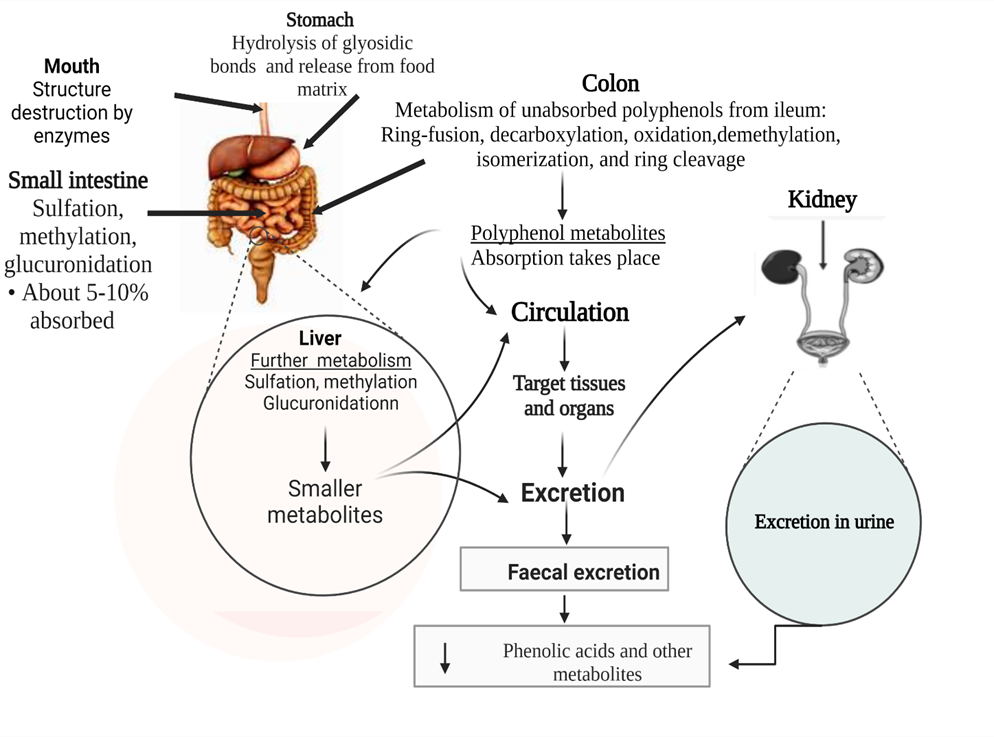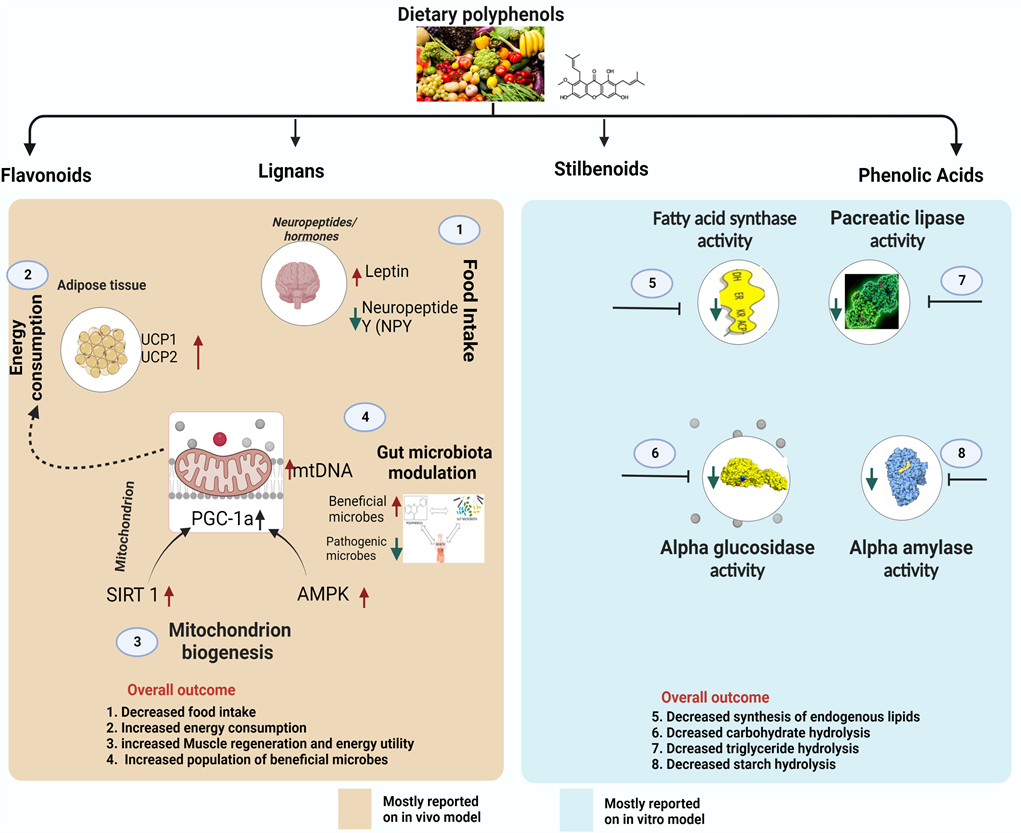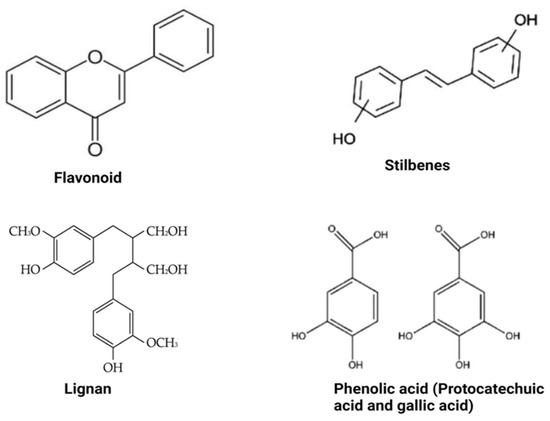1. Introduction
Obesity results from the excessive accumulation of body fat due to an imbalance between energy intake and expenditure. Obesity is a risk factor for several other chronic disorders, including type 2 diabetes mellitus, cardiovascular diseases, stroke, dementia, osteoarthritis, and breast, colon, and prostate cancers
[1][2][1,2]. It can contribute to a decline in life quality and expectancy and may also lead to many other psychological problems. Modifying lifestyle is considered the most appropriate approach to reducing obesity
[1]. In particular, adjusting an individual’s diet to include healthier foods is vital in weight management. Globally, obesity is constantly growing in prevalence and significance, posing a threat to health. Once just a problem of wealthy nations, obesity now impacts more countries at all economic levels, bringing with it a wave of ill health and loss of productivity among the population. The worldwide prevalence of the disease has doubled since the beginning of 1980
[3]. Today, obesity is considered one of the most serious public health concerns, with the latest figures from the World Health Organization’s database showing that about one in ten young people, ages 5–17, are overweight or obese, while the condition is even severe among middle-aged people
[3]. Bariatric surgery and synthetic drugs (such as orlistat and naltrexone/bupropion, glucagon-like peptide-1 receptor agonists) have been accepted as therapeutic strategies for obesity. However, these treatment methods have been associated with unpleasant side effects that limit their use
[4]. As a result of these concerns, other alternative approaches are needed to help fill this gap and reduce the impact of obesity among the population. This challenge has led to more research on obesity, including assessing the effect of polyphenols on disease.
Polyphenols are compounds with several hydroxyl groups on an aromatic ring. Most of these compounds can be found in several plant foods, including tea leaves, cereals, legumes, and fruits, while some are mainly associated with specific foods (e.g., isoflavones in soya, phloridzin in apples, flavanones in citrus, etc.). They can be grouped into two broad categories: flavonoid-type and non-flavonoid-types with distinct structures (Figure 1).
Figure 1.
Structures of flavonoids and Non-flavonoids polyphenols.
2. Flavonoid-Type Phenolic Compounds
Flavonoid-type phenolic compounds are further grouped into subclasses of flavanols, flavonols, isoflavones, flavanones, anthocyanins, and proanthocyanidins.
Flavonols are the groups of polyphenols containing a 3-hydroxyflavone base (3-hydroxy-2-phenylchromen-4-one) on their structure. They are distinguished from other polyphenols by hydroxy modification at distinct positions of the phenol residue
[5][22]. Foods with specified amounts of these compounds but lacking other active ingredients have demonstrated strong anti-obesity effects
[6][23]. Green tea rich in flavonols may reduce obesity through their thermogenic effect and increased fat oxidation
[6][23]; they can also inhibit enzymes involved in fat synthesis
[6][23].
Flavones have a basic structure consisting of a 2-phenyl-benzo-γ-pyrone skeleton formed by two phenyl rings (A and B) linked with a heterocyclic pyrone ring
[5][22]. They are said to have relatively higher bioavailability in the body compared to flavonols, probably because of degradation by gut microbiota and greater accessibility for absorption in the intestine
[5][22]. Flavones such as ellagitannins and granatin B present in the edible flowers of
Punica granatum L. were reported to exert a potent anti-obesity potential when consumed
[7][24]. The large numbers of hydroxyl groups on the flavone molecule are responsible for their α-glucosidase, α-amylase, and lipase inhibitory activities, which is the anti-obesity mechanism of their action
[7][24].
Isoflavones are differentiated from other flavonoids with their planar ring system containing benzenoid B ring attached to carbon number three (C3). Isoflavone-rich foods such as lentils, black soybean, chickpea, peanut, and common beans may demonstrate anti-obesity effects and suppressive ability against oxidation and inflammation associated with obesity
[8][25].
Anthocyanins may include and are not limited to delphinidin 3-
O-rutinoside, malvidin, cyanidin 3-
O-rutinoside, and cyanidin 3-
O-glucoside. Food products rich in these compounds, such as wine, berries, and beans, have beneficial effects on obesity
[8][25]. Anthocyanins effectively improve the lipid profile by significantly reducing serum triglyceride and cholesterol levels but increasing high-density lipoprotein-cholesterol concentration in obese conditions
[8][25]. Finally,
flavonols such as (+)-catechin, (−)-epicatechin, epigallocatechin, and some polymeric procyanidins can be found mostly in fruits, tea, wine and chocolate. They contain a B-ring attached to carbon number two (C2), even though they lack a carbonyl group in their carbon number four (C4) position or double bonds between carbon number two (C2) and number three (C3). Catechin-rich tea suppressed the expression of miR-335 in white adipose tissue
[9][26]. At the same time, proanthocyanin–rich grape seed extracts administered to rats significantly improved obesity parameters
[10][27], proving their efficacy as anti-obesity agents.
3. Non-Flavonoid-Type Phenolic Compounds in Foods
Non-flavonoid polyphenols are diverse in foods. They are categorized into phenolic acids, lignans, and stilbenes.
Phenolic acids are widely distributed in foods and can be found in high concentrations in grains, wine and berries. They may include and are not limited to caffeic acid, caftaric acid, ferulic acid, chlorogenic acid, and benzoic acid. Many physicochemical factors such as polarity, plant matrix, digestibility by gastrointestinal enzymes, and molecular mass can affect their bio-accessibility and bioavailability. Foods with high phenolic acid content have beneficial effects against obesity, primarily via modulating gut microbiota composition
[5][22]. On the other hand,
lignans consist of compounds with 1,4-diarylbutane in their structure. They include pinoresinol, secoisolariciresinol, syringaresinol, matairesinol, and lariciresinol diphenolic. These compounds are mainly found in fruits, vegetables, coffee, tea, and cereal products. When consumed, lignans express anti-obesity activity by inhibiting the expression of adipogenic factors and lipid metabolism-regulating factors during adipocyte differentiation
[11][28]. They are also said to be involved in inducing G0/G1 cell cycle arrest, inhibiting mitotic clonal expansion during the early stage of adipogenesis
[11][28]. The bioavailability of lignans requires biotransformation reactions involving demethylation and dehydroxylation, which are directly dependent on intestinal bacterial metabolism
[5][22]. Moreover,
stilbenoids may be found in red grapes, cranberries, strawberries, and peanuts
[5][22]. Resveratrol and its derivatives are the most known stilbenoids in the diet and probably the most significant and widely studied stilbenoids. Their metabolized form, such as dihydroresveratrol and 3,4′-dihydroxy-trans-stilbene (from trans-resveratrol), are responsible for their anti-obesity effects.
4. Integrating Polyphenols as Bioactive Ingredients in Foods
Phenolic compounds are broadly present in the plant kingdom and are arguably the most abundant and essential group of secondary metabolites in plants. Phenols from edible vegetables, cereals, legumes, and fruits are the most consumed dietary polyphenols. Consuming these foods or their products can potentially benefit patients suffering from obesity in disease management. The strategies to control body weight by incorporating active compounds capable of limiting the bioavailability of fats, stimulating energy expenditure, and modifying the composition of the gut microbiota into food products is envisaged as an appropriate method to find alternative treatment for obesity from natural products. There is a growing trend of incorporating bioactive polyphenols with anti-obesity effects into foods to treat and prevent obesity and other diseases
[12][29]. Using food enrichment, encapsulation, and formulation technologies can deliver active ingredients such as polyphenols in processed foods and improve the effectiveness of such foods against obesity
[12][29]. Manipulating products by adding plant bioactive metabolites has become a promising approach for controlling or treating obesity. Such efforts have been successful in producing products
such as fruit smoothies with high concentrations of added fruit polyphenols
[13][30], functional bread enriched with fruit polyphenols
[14][31], application of microencapsulation for the safe delivery of green tea polyphenols in foods
[15][32], infant food products such as fruit-based food (from blueberry, cranberry, chokecherry-rich polyphenols) for preventing/treating
obesity
[16][33], and drinking yoghurt with added fruit polyphenols
[16][33]. In addition to inhibiting obesity development, polyphenol-enriched foods have been stated to prevent obesity-associated disorders. Kiss et al. produced noodles fortified with polyphenol-rich buckwheat and amaranth powders
[17][34]. The antioxidant potential of the fortified product
was found to be higher than the control
[17][34]. Mayneris-Perxachs et al. also demonstrated that the supplementation of hesperidin and naringenin in biscuits positively influenced metabolic syndrome in obese rats
[18][35]. Incorporating polyphenols has positive effects in improving the anti-obesity metabolic properties of foods, and consuming such foods has protective effects against the development and progression of obesity.
5. Metabolism by Gut Microbes and Post Absorption Fate of Polyphenols
Polyphenol metabolism along the gut involves a series of stages. Figure 2 offers a detailed summary of the polyphenol metabolic process along the human gut.

Figure 2. Metabolism fate of polyphenols by the human gut microbiota. In the mouth, the structure of polyphenols is broken down by enzymes, releasing the compounds from the food matrix. In the stomach, the polymeric polyphenols and their glycosidic bonds are hydrolyzed as the digestion process continues. Once they reach the small intestine, polyphenols undergo enzymatic deglycosylation, and absorption of some digested compounds (5-10%) takes place. The absorbed phenolic compounds enter into the circulation and reach the liver where they are metabolized further into smaller metabolites. At the same time, in the large intestine, gut microbiota hydrolyses unabsorbed polyphenols, making them available for absorption into the bloodstream. Eventually, polyphenols metabolites are released from the body either through fecal matters or urine excretion.
6. Mode of Action against obesity
The mechanisms through which polyphenols can inhibit obesity include digestive enzymes (mainly alpha-glucosidase, pancreatic lipase, fatty acid synthase, and alpha-amylase), stimulating energy expenditure, suppressing appetite, regulating lipid synthesis, and modulation of gut microbiota (Figure 3). These mechanisms may occur individually or in certain combinations.

Figure 3. Mode of action for antiobesity of polyphenols.
↑,
Up-regulation;
↓,
down-regulation
7. Conclusion
Polyphenols are important phytonutrients in the diet. They offer the opportunity to improve nutrition by developing novel foods targeting different kinds of diseases. Emerging evidence from in vitro, in vivo, and clinical al studies suggests that dietary polyphenols play an important role in the prevention of metabolic diseases, including obesity, diabetes, and cardiovascular diseases. However, although these beneficial health claims are supported by experimental data, their effect on metabolic diseases still requires further investigation. The anti-obesity mechanisms of polyphenols have been explained by their potential to inhibit obesity-related digestive enzymes, modulate neurohormones/peptides involved in food intake, and their ability to improve the growth of beneficial gut microbes while inhibiting the proliferation of pathogenic ones. Thus, the ever-growing interest and public awareness surrounding the potential benefits of polyphenols, in addition to their widespread availability and accessibility through nutritional supplements and fortified foods, provoke the need for more research to unveil the benefits of these compounds.



